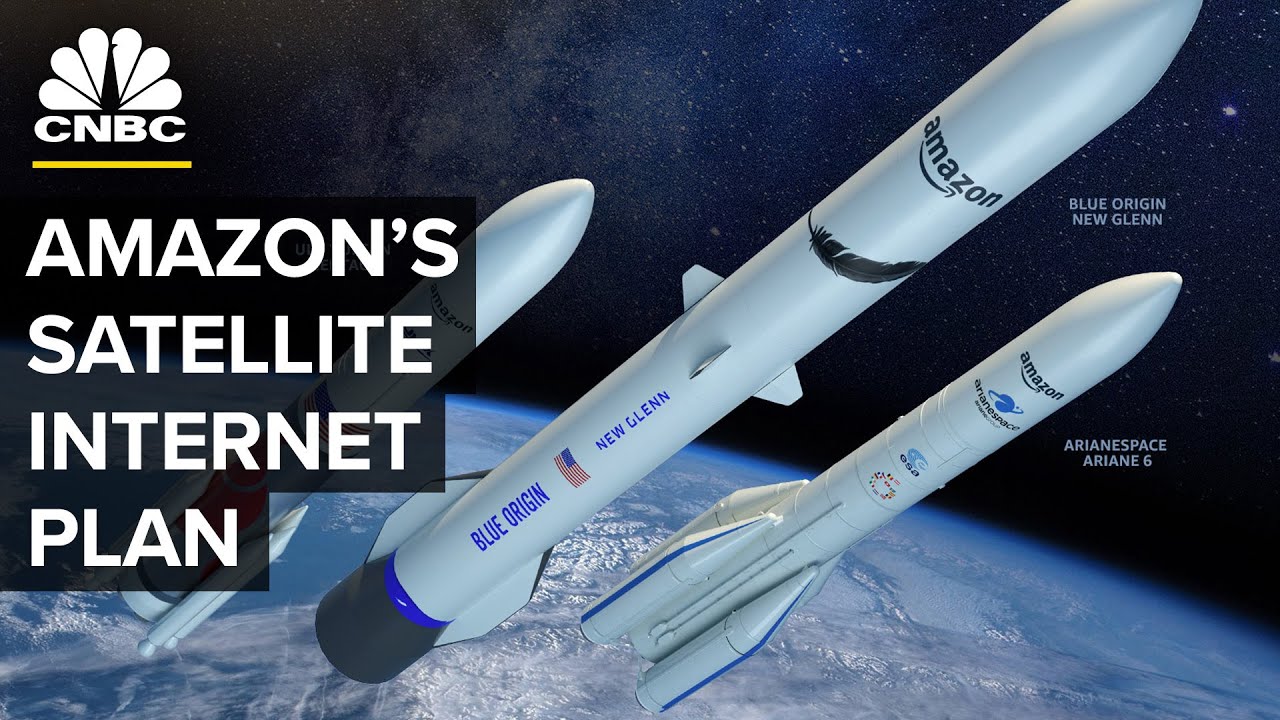The rivalry between Jeff
Bezos and Elon Musk is Heating up again, this time
over satellite internet. Project Kuiper is Amazon's
plan to deliver internet From space using 3,236
small satellites In low Earth orbit. In many ways, it's a
response and a competition To Elon Musk and SpaceX
with its Starlink network. Amazon is known as the
everything company, and it's Hard to have an everything
company without internet. So Amazon's fastest-growing
segment has been its AWS Cloud service. And in support of that,
they've built out a Tremendous amount of
internet infrastructure, Whether it's data centers
or fiber. Space is actually a very
natural expansion of 1. Their data business and 2. Their consumer business,
providing goods and Electronics and resources
to people around the world. SpaceX's Starlink already
has about 2,000 satellites In orbit, serving about
250,000 total subscribers. But the FCC has approved
SpaceX to launch a total of 12,000 satellites. Amazon has yet to launch
any. Amazon first revealed
Project Kuiper in 2019, but In early April, a big
announcement cemented the Project's momentum. Amazon recently signed a
multibillion-dollar contract In what is the largest
rocket deal in the Commercial space industry's
history, for launches of its Kuiper satellites with
three different entities, Blue Origin, Jeff Bezos'
space company, United Launch Alliance, which is the
joint venture of Boeing and Lockheed Martin, and
Arianespace, which is the European rocket maker.
The question now is, can the
e-commerce giant catch up to SpaceX? It is true that SpaceX has a
first mover advantage and Has more satellites
launched than Amazon. The advantage that Amazon
has is they have the chance To learn from Starlink's
mistakes. Amazon's Project Kuiper is
named for the outermost Asteroid belt in our solar
system. Amazon wants to launch its
satellites into low Earth Orbit at about 360 to 390
miles above the Earth's Surface, an orbit similar
to where SpaceX has its Satellites. The basis for
all satellite internet Networks involves three
components: a satellite Dish, a ground station and
the satellites themselves. The goal is to provide
connectivity to remote parts Of the planet, not served
by traditional internet Options like cable and DSL. Amazon has been fairly
tight-lipped about the Design of its satellites. However, they have stated
that these satellites will Be much bigger than those
being launched by SpaceX. The difference or the
reason for this is Amazon Needs spacecraft that are
going to be much more Powerful because they're
going to have fewer Spacecraft in the orbit
that they chose. And in order to deliver a
powerful signal to the Antenna or user terminal in
the ground, the spacecraft Has to do all the work. In April, CNBC's Andrew Ross
Sorkin got an exclusive, First tour inside Amazon's
Project Kuiper Facility in Redmond, Washington. The two buildings that are
here in Redmond, one is Focused mostly on R&D, to
create Kuiper Space Satellites, and base
stations and customer
Terminals, the satellite
dishes you'll put in your House. And then the room
we're in here is going to be The manufacturing line, at
least the first of the Manufacturing lines for the
actual satellites Themselves. An estimated 37% of the
world's population has still Never used the internet,
with 96% of those Individuals living in
developing countries. Many people, we grew up with
connectivity over modems and Things like that that all
ran over copper, that was Subsidized here in the U.S. In the forties and fifties
and sixties, and nobody's Upgrading that in rural
America and nobody is Upgrading that in
sub-Saharan Africa. And so what's happening is
people are leapfrogging to Mobile, but it's leaving
this gap in the home. And Kuiper, if successful,
is about bridging that. The satellite communications
market is one that's valued At a few tens of billions
of dollars. It's not uncommon for tech
giants to support digital Infrastructure, satellite
internet being one of those. Facebook invested in a satellite project, or Purchase capacity on a
satellite that, Unfortunately it blew up, but they spent considerable Money looking at space as a
way to extend their own Service, to bring more
people onto Facebook. And Google has financed
Fiber as well to bring more People online for their
service. What Amazon is Doing is part of a
continued trend of tech Giants building out
infrastructure that can Ultimately support their
own core services, which for Amazon would be e-commerce. Although the payout may be
huge, building out such Large satellite internet
networks is very expensive.
Both SpaceX and Amazon have
said that they expect to Spend over $10 billion to
develop their respective Constellations. For almost any other
company. That would be a Mammoth hurdle to get over. But Amazon spent roughly
$60 billion on capital Expenditures in 2021 alone. So compared to the average
company, this is a cost Amazon could actually get
its arms around and it Doesn't threaten capsizing
the program, provided they Can keep it within that
cost estimate. Trying to build this kind of
global satellite internet Network is much less of an
existential threat to the Existence of the business
of Amazon versus the Business of SpaceX, because
Amazon does so many other Things. Whereas for SpaceX,
this is their largest other Project alongside it's
building its Starship Rocket. SpaceX charges $110 per
month for its baseline Internet service, and
customers have to pay $599 For a Starlink satellite
dish. Amazon has not yet revealed
how much its internet Service will cost, but
Kuiper will follow a similar Business model, with
customers paying for a Subscription and a
satellite dish. Amazon recently disclosed
that its Kuiper satellite Antennas, which consumers
would use here on the Ground, are under a cost of
$500 apiece. By comparison, SpaceX,
which has been selling its Starlink hardware for about
$600 apiece, has disclosed Last year that it cost the
company around $1,300 Dollars for each of its
antenna, meaning that it's Subsidizing roughly half of
the price of those Starlink Hardware to deliver the
service to customers on the
Ground. Several constellations,
Starlink not being the Exception, have tried first
with the spacecraft in hopes That they would solve the
antenna later. And what ultimately results
from this, or what has Resulted in the past, is
the antenna has remained too Costly for the service to
ever be truly widespread. Another area where Amazon
has a head start is its AWS Ground station
infrastructure. The biggest advantage for
Amazon is that they can link Their constellation
directly back to the Internet using their own
infrastructure. So if you have an Amazon
Kuiper terminal on your House, it's going to link
to the satellite and then it Needs to link back to the
internet somewhere else. For Starlink, they have to
set up those gateways back To the internet using other
service providers, either Other cloud network service
providers, or find ways to Stitch Starlink back into
the internet. One of those service
providers is Google. In 2021, SpaceX signed a
deal that allows the company To install ground stations
at Google data centers Around the world. AWS has a network backbone. It's close to the internet. Lots of people are hosting
on it. So if we can interconnect
our base stations to that AWS network, we're
automatically advantaged in That case for customers to
get better bandwidth. Billing is something that
we do a lot and we're riding On the shoulders of all
that building Infrastructure.
Manufacturing is a big, hard Component of this. We have
to build over time tens of Millions of customer
terminals, but in the device
Business, we build tens of
millions of things every Month. And so it gives us
the opportunity to use the Expertise of that design
and manufacturing and bring It over here. Even with its deep pockets
and extensive experience Producing consumer
electronic devices at scale, Amazon still faces a number
of challenges in making its Satellite internet a
reality. One of the biggest hurdles
to getting such a network up And running, especially
when we were talking about This number of satellites,
is getting them into orbit. To get its constellation
into space, Amazon has Contracts for 38 launches
with United Launch Alliance, 18 launches with
Arianespace and 12 launches With Blue Origin, with an
option for as many as 15 Additional launches with
the private venture that's Owned by Amazon founder
Jeff Bezos. Each of the rockets that
Amazon is relying on to Launch Kuiper are at least
two years behind schedule. And on top of that, the
challenge most new rockets Face is not just getting to
the launch pad for the first Time, but scaling to launch
to three, five, ten times a Year. Our research shows
that for the first five Years of a rock's
existence, the average Flight rate is around 2.75,
meaning they struggle to Launch just three times a
year during their early Years. And time is not necessarily
on Amazon's side. So Amazon's self-stated
biggest driver is to meet Regulatory milestones set
by the U.S. Federal Communications
Commission. That body Requires Amazon to have
half of its constellation in Orbit by July 2026 and the
full constellation by July 2029.
If, say, they only launched
1,000 satellites by that Time, their authorization
would be capped at 1,000 Satellites, at the number
that they launch by the time Of the deadline. Amazon has never put
anything into space, so That's the first challenge,
which is we have to get a Couple of prototype
satellites up and and test Them. Everything simulates
really well and it's coming Together really well. We've
built a great team, but Until you're putting
something in space, it's Just not a friendly
environment. Amazon plans to launch two
prototypes into orbit by the End of this year, before
beginning to launch Operational satellites. Apart from SpaceX, Amazon
will have to contend with Other players in the
internet satellite business, Including OneWeb and more
traditional satellite Providers like ViaSat and
Hughes. The good news for Amazon is
that many experts don't Think satellite internet is
a winner-take-all business. No one in this industry
believes that it's a One-system-take-all kind of
environment. We expect to see at least
two and probably more Constellations go forward,
serving not only the Residential consumer, but
any type of business or Organization that relies on
internet connectivity. It's ambitious. It's also something that
five people in a garage Can't do, you know. So, if we are going to do
good things for society, This is something that,
because Amazon does have Scale, we do have a balance
sheet, that this is the kind Of initiative, even though
it's risky, it could fail, It's the kind of initiative
that we can and should take
On.





